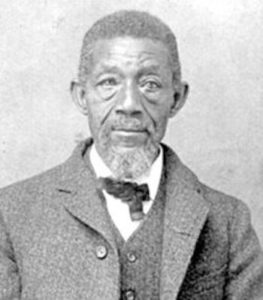
Solomon G. Brown
*Solomon G. Brown was born on this date in 1829. He was a Black laborer, telegraph assistant, poet, lecturer, scientific technician, and the first Black employee of the Smithsonian Institution.
Solomon Galleon Brown was born in Washington, D.C., the fourth of six children to his parents, Isaac and Rachel Brown. His parents were former slaves, but he was born a free man. His father died in 1832, and his family was left homeless with heavy debt. Brown could not be formally educated because he had to work to support his family. When he was fifteen, he worked as a postmaster assistant at the Washington D.C. Post Office. Part of his duties in 1844 and 1845 was assisting Joseph Henry, Samuel F.B. Morse, and Alfred Vail with installing the first Morse telegraph.
When the Morse Telegraph Company was formed, Brown left the post office, and for the next seven years, he continued to work for Morse as a battery tender. He then took a position as an assistant packer at Gillman & Brothers manufacturing company in their chemical laboratory. At this time, he worked for the general land office and in bookbinding. Brown's status in Washington D.C. as a free Black man in a slave society was not without stress, and on July 21, 1858, Brown obtained a certificate of freedom, in which a white friend swore in front of a justice of the peace that Brown had always been free.
Smithsonian Institution
In 1852 he was appointed to the foreign exchange division of the new Smithsonian Institution by his former boss at the Morse Telegraph Company, Joseph Henry. In 1864, he became a museum assistant, and by 1869 he was the registrar in charge of transportation, registry, and storage of animal specimens and materials received by the institution. Out of all the three secretaries he worked with, he worked closely with Spencer Baird. Spencer Baird was a successful ornithologist, and Brown spent much time assisting him. When Baird was out of town, he trusted Brown to be the "eyes and ears" of the Smithsonian. Brown would do clerical duties for Baird; for example, he entertained visitors, opened and forward mail, made the Baird family's travel arrangements, and gave out wages to the workers of the Baird household.
During his career at the Smithsonian, he worked for the National Museum, the International Exchange Service, the Bureau of American Ethnology, and the National Zoological Park. He had many duties within the Smithsonian, including working as a general laborer who built exhibit cases, moved and cleaned furniture, prepared maps, and drew for Smithsonian lectures. He worked under the first three Smithsonian secretaries, Joseph Henry, Spencer Fullerton Baird, and Samuel Pierpont Langley.
Personal life
In his personal life, he married Lucinda on June 16, 1864. They did not have children, but they had a large family of nieces (some they adopted) and boarders, including William J. Simmons. Together they would have picnics for their local community.
Outside the Smithsonian
Brown volunteered in civic and educational programs to help the African American community. He was the founder of the Pioneer Sabbath School in Washington, D.C., and the North Washington Mission Sunday School superintendent. He helped organize the Pioneer Sunday School association in the Hillsdale neighborhood and was superintendent of the association from 1868 to 1888. Brown, along with Fred Smoot and Mark McKenzie were early settlers and civic leaders of the Hillsdale neighborhood, which was created on the land of the former Barry Farm under the supervision of the Freedmen's Bureau.
He was a trustee of Wilberforce University, the 15th Street Presbyterian church, and the D.C. public schools. He was the superintendent of the North Washington Mission Sunday School and an active member of the Freedmen's Relief Association. He was also commissioner of the poor in the County of Washington. He was elected president of the National Union League in 1866, a political organization in the south of the United States for Blacks. He served three terms as a Republican member of the House of Delegates for Washington, D.C., from 1871-1874. He represented all the people who lived in Anacostia and was the first member to be certified by the governor of Washington, D.C.
He was a member of numerous lyceums’ including the Galbraith in D.C and the St. Paul Lyceum in Baltimore and gave frequent lectures on scientific questions in Baltimore, Alexandria, and Washington, D.C. His first lectures were in January 1855, and Brown gave lectures on subjects from insects to geology to the telegraph. Brown created the diagrams used in the lectures. In connection with these, he prepared or assisted in preparing nearly all the important diagrams for scientific lectures given at the Smithsonian during his tenure there. He was an officer in the District Grand Lodge of Masons and was an assistant honorary commissioner of the colored department of the 1884 New Orleans Exposition World's Fair for D.C.
He was director of the Industrial Saving and Building Association of Washington, D.C., and the Washington correspondent of the Anglo-African Christian Recorder. He also edited the column "Sunday school Circle" of the Christian Index, a publication from Jackson, Tennessee. Brown was also part of the National Black Leadership Committee that arranged for the unveiling of Thomas Ball's sculptor Emancipation Memorial Monument in Washington's Lincoln Park. Many people, like President Ulysses S. Grant and Frederick Douglass, attended the unveiling. Brown spent some time writing poetry, some of which appeared in the local Black newspapers, such as "The Washington Bee."
He retired on February 14, 1906, and died at his home on June 26, 1906. His funeral was officiated by Francis James Grimke, the pastor at the Fifteenth Street Presbyterian Church, where he was a member. In 2004 a few trees were planted around the National Museum of Natural History in his honor. When the National Museum of African American History and Culture opened in 2016, it named its fifth-floor Council and conference lounge space the Solomon G. Brown Room.